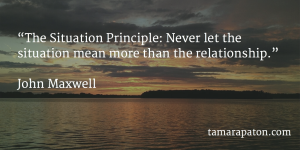

Getting noticed by boards can be challenging. Sharing your aspirations to serve can feel like trying to be heard at a crowded, loud party with music blaring in the background.
If this sounds familiar, you are not alone.
As a corporate director and coach for those trying to become one, I have met hundreds of richly talented people. They have decades of experience, valuable skills, and a drive to make a difference on boards. Unfortunately, many will wait far longer than necessary to achieve their goals. Why? They lack a platform.
Michael Hyatt, author of Platform: Get Noticed in a Noisy World, makes it plain:
“Without a platform — something that enables you to get seen and heard — you don’t have a chance.”
Before we go further, let’s begin with a definition. A platform is your collection of contacts, customers, prospects, followers and fans. In other words, they are your tribe of people who are glad to trust you and value your insight.
The importance of a platform isn’t limited to those looking to sell something or make their mark on a public stage. All of us — including aspiring directors — can benefit from developing a network of people who identify with us and share our passions.
The benefits of having a platform
The first step in becoming known for knowing something is being seen. The corporate governance field is crowded with 10,000 members of the Institute of Corporate Directors and 16,000 members of National Association of Corporate Directors. Thoughtful development of a platform elevates your voice and brand above the noisy masses.
Once you are visible, a platform allows you to be heard and demonstrate your value. Today, anyone can develop and access the figurative sound system to boost the reach of your message. Those who succeed won’t stop with a one-way conversation, however. Instead, the resulting conversations can evolve our thinking and expand the reach of our influence.
How to start developing your platform
In past posts, I have stressed the importance of being able to articulate what you bring to a board (here, here and here). Assuming you are clear on your offer, it’s time to introduce your unique perspective on hot boardroom topics. Whether you want to opine on cybersecurity, talent management, digital disruption, or customer insight, everyone has access to an extensive range of tools.
1. Writing
Economist John Maynard Keynes admitted that “the difficulty lies not so much as in generating new ideas, but in escaping old ones.” With this challenge in mind, the act of writing organizes my thoughts, prompts me to seek new data, and evolve my point of view. Informed by your questions and feedback, I develop more nuanced thinking on topics that matter deeply to me.
[Tweet “In short, my blog is my workbench for governance thought leadership.”]
In a short time, a blog creates a home base from which you can build an online presence. Listening to and participating in conversations on various social media sites can signal where you might plant stakes. For example, a colleague of mine built professional momentum by sharing his writing on LinkedIn and Huffington Post. Similarly, I’m in the midst of expanding two recent blog posts for publication in industry magazines.
This tutorial can help you get started with the basics of blogging. I found it easy to handle the technical details with a self-hosted WordPress site housing my work. This tutorial walks you through the set-up in 20 minutes. And when you are ready to write, this free webinar outlines a recipe for powerful posts.
2. Public speaking
Once you have tested your thought leadership online, you’ll be ready to share it from a stage. The proliferation of TED-inspired events creates endless opportunities to stand up for something by speaking in front of a crowd.
As you get started, you may find that professional associations offer a welcoming stage for thought leaders. For example, I’m looking forward to speaking at an engineering conference next month and I remain grateful for the opportunities I’ve enjoyed with Women Get on Board. Corporate training companies are another good option, as they often seek subject matter experts on hot topics.
3. Networking and serving others
Although your writing and speaking can reach an unlimited audience, we also benefit from the intimacy of one-on-one relationship building. See my past posts on networking tips for introverts and ways to effectively leverage one-on-one meetings.
Volunteer service can be another supporting peg under your platform. A desire to meet professionals in my new hometown prompted me to serve on a non-profit board. Providing pro-bono consulting services also demonstrates your potential contribution in board environments.
Whatever tools you use, I encourage you to think hard about what matters to the people you are trying to reach and serve. Author Seth Godin challenges each of us create something remarkable with a specific tribe in mind.
“Build something that people will look for, something that people will talk about, something we would miss if it were gone.
Not for everyone. For us.”
Admittedly, doing all of the above at once may seem overwhelming. But there is a reason to make the effort: relatively few people bother. When others think they are leveraging social media by tweeting the occasional update, consistent delivery of valuable insights will lift your visibility and connect you with board decision makers.
Social media guru Gary Vaynerchuk encourages us to roll up our sleeves and dedicate meaningful time:
“So this new quick hack of using social media and modern tech to build up your brand isn’t enough. It just isn’t. There is no substitute for honest hard work. You have to earn the privilege of building a “personal brand”, and the only way to do that is to actually execute.”
This guidance doesn’t scare me off, but rather steels my commitment. I’ve seen the benefits of consistently delivering value and nurturing relationships along the way. And I’m grateful to you for supporting my journey.
Question: How do you build your platform? What impact has your investment made on your career?
Thank you for reading! If you found it useful, please click the “like” button on LinkedIn or tweet a comment. Doing so helps my work reach others and would mean so much to me.








